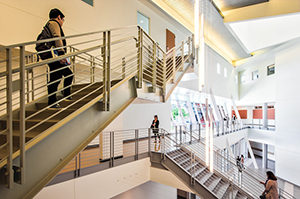By Jessie Fetterling
MISSION VIEJO, Calif. — The $55 million Sciences Building recently debuted at Saddleback College in Mission Viejo as part of a large-scale renovation to boost the college’s environmental sustainability as well as its overall learning experience.

Irvine, Calif.-based C.W. Driver Companies built the three-story, 81,980-square-foot facility, which features 26 modern laboratories, classroom space and office space in addition to a 500-square-foot observatory with 22 student-accessible telescopes. School Construction News spoke with Brian Dougherty, senior partner at Costa Mesa, Calif.-based Dougherty+Dougherty Architects LLP, the architect on the project, to learn more about the facility’s advanced learning spaces and technologies.
Q: What advantages can the Sciences Building’s high-tech learning spaces offer students?
Dougherty: One of the core design parameters for the project is that learning occurs everywhere in the facility. This includes labs, classrooms, offices and public spaces. Within this context, it is the expectation that all occupants will have access to technology anytime, anywhere and on any device. The building is infused with wireless access ports and large bandwidth. As a result, students are able to exchange information between classes and online with the faculty throughout the day in every alcove within the building.
The advantage is that the entire building becomes an educational environment in a free-flowing and dynamic setting for learning. Within the formal teaching labs and classrooms, an integrated Crestron system draws all platforms into a universal portal for presenting, sharing and re-airing content. Faculty can broadcast to in-room projectors or from their computers and tablets while live streaming demonstrations both locally and remotely. This content is recorded for future reference, which allows students who may have missed a class to revisit the content on their own schedule, further enhancing their ability to absorb the material and integrate information across classes.
Q: What other key technologies are featured in the new Sciences Building?
Dougherty: The Saddleback Sciences Building features technologies that are focused on both the student experience and the building operation. Certified as a LEED Gold project, the facility features systems that are highly integrated and aimed at the reduction of resource consumption while providing a healthy and active learning environment. The lighting and HVAC systems are integrated with the building management system to optimize energy consumption. Lighting controls allow auto adjustment of the illumination levels based on available sunlight.

Photo Credit (all): Nils Timm/Slinmmit Inc.
With today’s concerns about student safety, the building access, both exterior and interior, is monitored and controlled from the campus police station and allows for remote lock down and modifications in addition to key-card entry, which records all movement within the building outside normal class hours.
Q: Is the observatory space common for facilities of this type, and what planning went into the design of that space?
Dougherty: Saddleback College, as a part of their science curriculum, has a very strong portfolio in astronomy and physics. This expanding area of study has struggled with the limited resources of the existing facility and has taken the opportunity with the new facility to create a setting that elevates their physical setting to match their aspirations. While it is not unusual to see small observatories at the college level it is unusual to find a commitment that provides the level of high-quality equipment with high student access in a very hands-on setting.
The large telescope has been placed within a state-of-the-art dome that is at the most remote edge of the campus to minimize both light pollution and building vibration. Through technology, the instruments can be accessed and controlled remotely from the main astronomy and physics labs in the new Sciences Building providing direct access to the experience of the telescope without the need to be physically in the same space. To augment this experience, an adjacent facility has been constructed to allow the day-to-day installation of an array of smaller telescopes, which can be directly operated by a full class in a more traditional setting.
Q: What were the biggest challenges on the project and how did you overcome those challenges?
Dougherty: The two greatest challenges for this project were the site and the complexity of the building systems. The Sciences Building is located at the base of a sloping site that links the original upper campus with the more recently developed lower campus. The underlying geologic formation challenged our engineering team to develop a foundation that would address the non-uniform subsurface formations and the programmatic desire to have the building create a vertical ‘bridge’ to link the campus. A matrix of drilled caissons taken, in some cases, more than 100 feet to bedrock underpin the structure to stabilize the subsurface conditions and provide a platform for the facility. All of this is interlaced with a dense array of infrastructure to serve the building systems. The use of Building Information Modeling (BIM) that integrated the architectural and engineering design with the contractor’s implementation of those systems allowed the team to develop a shared strategy for moving the project forward.


